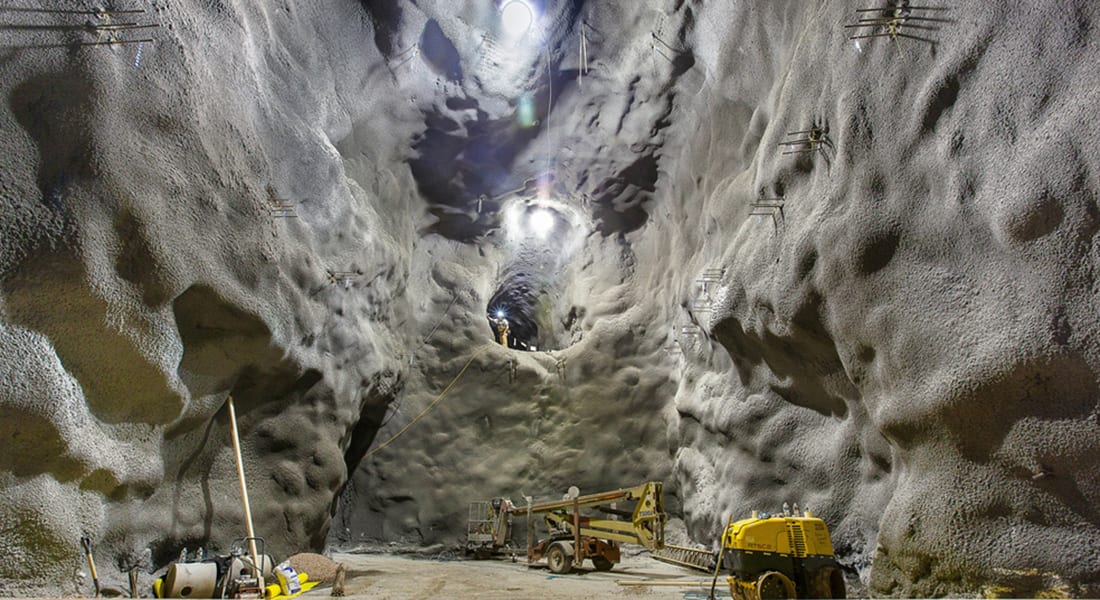Groundbreaking held today in South Dakota marks the start of excavation for the Long-Baseline Neutrino Facility, future home to the international Deep Underground Neutrino Experiment.
SMU is one of more than 100 institutions from around the world building hardware for a massive international experiment — a particle detector — that could change our understanding of the universe.
Construction will take years and scientists expect to begin taking data in the middle of the next decade, said SMU physicist Thomas E. Coan, a professor in the SMU Department of Physics and a researcher on the experiment.
The turning of a shovelful of earth a mile underground marks a new era in particle physics research. The groundbreaking ceremony was held Friday, July 21, 2017 at the Sanford Underground Research Facility in Lead, South Dakota.
Dignitaries, scientists and engineers from around the world marked the start of construction of the experiment that could change our understanding of the universe.
The Long-Baseline Neutrino Facility (LBNF) will house the international Deep Underground Neutrino Experiment. Called DUNE for short, it will be built and operated by a group of roughly 1,000 scientists and engineers from 30 countries, including Coan.
When complete, LBNF/DUNE will be the largest experiment ever built in the United States to study the properties of mysterious particles called neutrinos. Unlocking the mysteries of these particles could help explain more about how the universe works and why matter exists at all.
“DUNE is designed to investigate a broad swath of the properties of neutrinos, one of the universe’s most abundant but still mysterious electrically neutral particles,” Coan said.
The experiment seeks to understand strange phenomena like neutrinos changing identities — called “oscillation” — in mid-flight and the behavioral differences between a neutrino an its anti-neutrino sibling, Coan said.
“A crisp understanding of neutrinos holds promise for understanding why any matter survived annihilation with antimatter from the Big Bang to form the people, planets and stars we see today,” Coan said. “DUNE is also able to probe whether or not the humble proton, found in all atoms of the universe, is actually unstable and ultimately destined to eventually decay away. It even has sensitivity to undertanding how stars explode into supernovae by studying the neutrinos that stream out from them during the explosion.”
Coan also is a principal investigator on NOvA, another neutrino experiment collaboration of the U.S. Department of Energy’s Fermi National Laboratory. NOvA, in northern Minnesota, is another massive particle detector designed to observe and measure the behavior of neutrinos.
Similar to NOvA, DUNE will be a neutrino beam from Fermilab that runs to Homestake Gold Mine in South Dakota. DUNE’s beam will be more powerful and will take the measurements NOvA is taking to an unprecedented precision, scientists on both experiments have said. Any questions NOvA fails to answer will most certainly be answered by DUNE.
At its peak, construction of LBNF is expected to create almost 2,000 jobs throughout South Dakota and a similar number of jobs in Illinois.
Institutions in dozens of countries will contribute to the construction of DUNE components. The DUNE experiment will attract students and young scientists from around the world, helping to foster the next generation of leaders in the field and to maintain the highly skilled scientific workforce in the United States and worldwide.
Beam of neutrinos will travel 800 miles (1,300 kilometers) through the Earth
The U.S. Department of Energy’s Fermi National Accelerator Laboratory, located outside Chicago, will generate a beam of neutrinos and send them 800 miles (1,300 kilometers) through the Earth to Sanford Lab, where a four-story-high, 70,000-ton detector will be built beneath the surface to catch those neutrinos.
Scientists will study the interactions of neutrinos in the detector, looking to better understand the changes these particles undergo as they travel across the country in less than the blink of an eye.
Ever since their discovery 61 years ago, neutrinos have proven to be one of the most surprising subatomic particles, and the fact that they oscillate between three different states is one of their biggest surprises. That discovery began with a solar neutrino experiment led by physicist Ray Davis in the 1960s, performed in the same underground mine that now will house LBNF/DUNE. Davis shared the Nobel Prize in physics in 2002 for his experiment.
DUNE scientists will also look for the differences in behavior between neutrinos and their antimatter counterparts, antineutrinos, which could give us clues as to why the visible universe is dominated by matter.
DUNE will also watch for neutrinos produced when a star explodes, which could reveal the formation of neutron stars and black holes, and will investigate whether protons live forever or eventually decay, bringing us closer to fulfilling Einstein’s dream of a grand unified theory.
Construction over the next 10 years is funded by DOE with 30 countries
But first, the facility must be built, and that will happen over the next 10 years. Now that the first shovel of earth has been moved, crews will begin to excavate more than 870,000 tons of rock to create the huge underground caverns for the DUNE detector.
Large DUNE prototype detectors are under construction at European research center CERN, a major partner in the project, and the technology refined for those smaller versions will be tested and scaled up when the massive DUNE detectors are built.
This research is funded by the U.S. Department of Energy Office of Science in conjunction with CERN and international partners from 30 countries.
DUNE collaborators come from institutions in Armenia, Brazil, Bulgaria, Canada, Chile, China, Colombia, Czech Republic, Finland, France, Greece, India, Iran, Italy, Japan, Madagascar, Mexico, the Netherlands, Peru, Poland, Romania, Russia, South Korea, Spain, Sweden, Switzerland, Turkey, Ukraine, United Kingdom and the United States. — Fermilab, SMU

